From
my recent diary
2016
Saturday, December 3 and December 4 Sunday
Saturday
One weather forecast company predicted clear sky, and another said it
remained cloudy through the night. I got out of my bed thinking which was
correct. The result was was unclouded.
I arrived at usual observing site at 2:33p.m. local time. There was no
snow around my house but snow depth here was 7 cm with air temperature of
+2 ˚C. It took some 10 minutes to remove snow for setting my telescope. I
completed setting my comet-seeker at 3:15a.m. and looked up the sky. Cloud
began to cover the sky that was cloudless a few minutes before. At
3:20a.m. it got cloudy completely.
I waited for a while but there was no expectation for the recovery. I sat
on the seat of my car and sometimes looked the sky up. It seemed that the
cloud was getting thicker with time. I had a nap and waited but there
appeared no gap in the cloud. I had been in my car patiently until
5:30a.m., 20 minutes after the start of twilight. After all, I took down
my comet-seeker without using it, and I got back home. I have experienced
such pattern so many times, i.e. it got cloudy one or two hours before the
beginning of twilight this year.
Sunday
At the observing site, cloud covered large portion of the sky. While I was
setting up my comet-seeker, I was afraid the sky would be hidden by the
cloud like yesterday. When I started the session the amount of cloud was
as high as 70 to 90% of the enter sky, and I trained my telescope at a gap
of clouds. The gap disappeared in less than three minutes, and I aimed my
telescope at another gap.
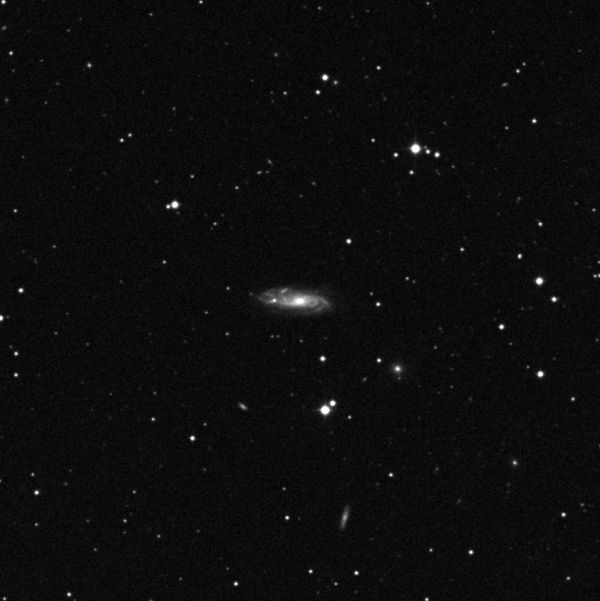
NGC5918, a galaxy in the constellation of Bootes. The image is 15f wide.
The Digitized Sky Survey copyright © 1994
Some 30 minutes before the start of twilight, the sky got clear except for
the east. Air temperature dropped from +2˚C to -3˚C because of this
change. Nevertheless, there was very thin cloud here and there on the sky,
and not perfectly clear. I identified NGC5678, 5676, 5667, 5918, M13,
NGC6207, and 5689. Visual magnitude of NGC5918 is 13.2, but I was sure I
could notice DSO or comet one magnitude darker.
Snow depth was 7 cm yesterday and it reduced to 3 cm today, but the site
will be inaccessible soon due to snow. I think this was the last visit of
this site this year.
Sunday, November 13
I went on a comet hunting on Tuesday, November 8, but thin cloud spread
when I set up my comet-seeker. I must swept the sky through thin cloud.
Today, it was cloudy again and I did not expect clear sky either.
Moonset was at 4:16a.m. local time, and I had to search under the
moonlight for 20 minutes. The beginning of twilight was 4:56a.m. that
meant the dark night period was merely 36 minutes. I began with Alpahard,
alpha Hydrae, and soon the sky got perfectly clear. However, the
background of the FOV was bright because of moonlight. I attached a light
pollution filter, IDAS LPS-P2, and I settled back to comet hunt.
Stars boosted their brightness coinciding with the moonset and I removed
the light pollution filter. I moved my comet-seeker downward as if I swept
star dust shining on the sky. The first DSO that I identified today was a
galaxy in Sextants, NGC3110, with the magnitude of 12.7. Thanks to good
transparency the galaxy looked bright. After a while, my telescope reached
on the horizon. I moved the FOV some 0.2˚ to the north (rotate the
telescope counter clockwise) and I took my eye off the eyepiece. I trained
my comet-seeker at an altitude of around 40˚ at one time, and again I
swept the sky toward the horizon. A comet like object grazed the edge of
the FOV. It was a bright galaxy NGC3115 in the same constellation,
Sextants. The center of this galaxy was out of the FOV, i.e. I was about
to overlook this galaxy due to poor overlapping the FOV.

Bright galaxy NGC3115 and PGC29300 (lower galaxy).
The Digitized Sky Survey copyright © 1994
I have ever observed this galaxy tens of times, but I noticed the nearby
galaxy, PGC29300, for the first time. This object is the magnitude of 13.3
with apparent diameter of about 1f, but it was difficult to observe under
poor transparency because of the low surface brightness. I think I could
identify the galaxy since I increased regular magnification from 68x (FOV
of 1.3˚) to 78x (1.1˚) and now 97x (1.0˚) and at the same time my
observing site at present is at high elevation, 960 m above sea level.
The only DSO I observed after PGC29300 was NGC3585 (mag. 9.9, altitude of
17˚), but I could not observe NGC3242 (Ghost of Jupiter) and some galaxies
that were in the area I searched. I have no idea why I could not. There
were some possible reasons: sometimes seeing getting bad, poor overlapping
of FOV for sweeping, and carelessness.
I observed 144P Kushida at the beginning of twilight. The apparent
diameter was 1f. Nonetheless, it was diffused with the magnitude of 12 and
on top of that zodiacal light made it difficult to observe. The image of
comet was challenging to spot during the hunting session. I applied the
comet filter and the image was much intensified to be detected during the
searching.
After observing this comet, I swept the sky for 30 minutes and I finished
todayfs session. Finally, I enjoyed a starry dark night.
Thursday November 3 and Sturdy November 5
Thursday
When I arrived at the site the sky condition was the best through the
summer and autumn in this year. I could observe the elongated counterglow
with direct vision by naked eyes. Actually, I experienced jaw-dropping
starry night on Monday, October 31 too, but clouds started covering the
sky only in six minutes after the beginning of the comet hunting session
at that time. I was forced to search through thin cloud after that.
While I was setting up my comet-seeker, clouds started to appear on the
sky. The clouds hid the sky except for the south in a minute. The only
star I could see needed for the alignment of Nexus DSC was Sirius. I
waited for some 10 minutes and finally, I noticed Regulus appeared through
thin cloud and I aligned the digital setting circles.

Galaxy group in Canis Major, NGC2293, 2293 and 2295. The image is 15f
wide.
The Digitized Sky Survey copyright © 1994
I began with Sirius, and a galaxy group came into the FOV in a second.
They were NGC2292, 2293 and 2295 that are nestling together. Their
magnitudes are 10th to 12th but I did not know there are such galaxies in
Canis Major. I observed when they were at the meridian, but usually, I
sweep the area when the altitude is much lower. That explains I probably
have not identified those galaxies ever before.
I moved my comet-seeker toward lower part of the sky, and then, I
encountered a globular cluster, NGC2298. This object was bright with a
magnitude of 9.3, but I thought I have never observed it. Though the
cluster was also at transit, the altitude was only 17 ˚.
After identifying this object, there appeared cloud on the south also, and
I was forced to search small gap in clouds in every direction.
Saturday
In October I conducted comet hunting sessions five times. However, they
were either moonlight nights or the nights with high amount of cloud. In
todayfs session, finally, I enjoyed cloudless sky without moonlight.
Nonetheless, counterglow was not very clear in comparison with that on
Thursday.
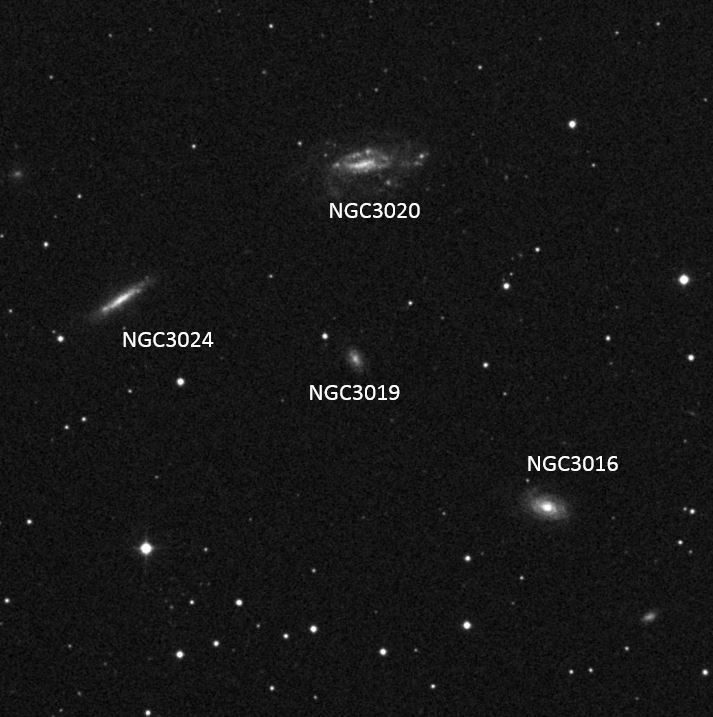
NGC3016, 3020, 3024 in Leo. NGC3015 was too dark to be observed. The image
is 15f wide.
The Digitized Sky Survey copyright © 1994
I began to sweep on the east-southeast. The back ground of the FOV was
much brighter than on the other day due to bright zodiacal light. I
improved the S/N ratio using a light pollution filter, IDAS LPS-P2. The
first comet like object I identified was a galaxy group in Leo, NGC3016,
3020 and 3024. Though their magnitudes are 12th to 13th, it was nearly the
limit of my comet-seeker because of zodiacal light. I have never observed
the 11th galaxy near Regulus, UGC5470, during the searching session.
Today, I could manage to notice this object because of paying attention to
it, but in my impression it was impossible to note this galaxy during the
session due to zodiacal light.
I could not identified 144P Kushida that was in the area I searched. I
aimed my telescope at this comet using SkySafari 5 Pro with Nexus DSC, but
I could not spot it. I attached Comet Filter made by Lumicon, and finally,
I managed to notice this comet. I measured the diameter of 0.1f with the
magnitude of 12 by intuition. At 4:51a.m. local time, six minutes after
the beginning of twilight, I identified M104. The altitude was merely 9˚
above the horizon, but the dark lane in the galaxy was evident. A few
minutes later, I spotted NGC4030 and I completed the session. There are
many galaxies in the north of this point, and at the same time it was the
area where I discovered 332P Ikeya-Murakami six years ago on November 4
local time.
Wednesday, October 12 and Saturday October 15
Wednesday
On Wednesday I conducted a comet hunting session for the first time this
month; I did it last on Monday September 5. The weather has been
incredibly bad for these six weeks.
At this predawn the sky was crystal clear at the usual observing site, and
I set up my comet-seeker with enthusiasm. However, when I completed
setting my telescope up, most part of eastern sky was coved with cloud. I
wanted to search the south-east aiming at discovering a sungrazer, but the
north-east was the only part of the eastern sky where there was no cloud.
I trained my comet-seeker at the north-east and swept the sky. I could
identified three galaxies, NGC3941, 4214 and 3675, during 23 minutes of
searching but clouds hide the area I searched.
I trained my comet-seeker where there was a gap of clouds, but I could not
conduct a steady hunting session because the amount of cloud increased as
time went. Even so, I managed to comet hunt for 50 minutes.
Saturday
Again, the sky was perfectly clear, but the dark night period at this
predawn was only five minutes. Moon set was at 4:21a.m. and the twilight
started at 4:26a.m. I began searching at 3:50a.m. with my 46 cm
comet-seeker using a light pollution filter (IDAS LPS-P2) to reduce the
influence of moonlight. The search area was the south-east with being
conscious of discovering a sungrazing comet.
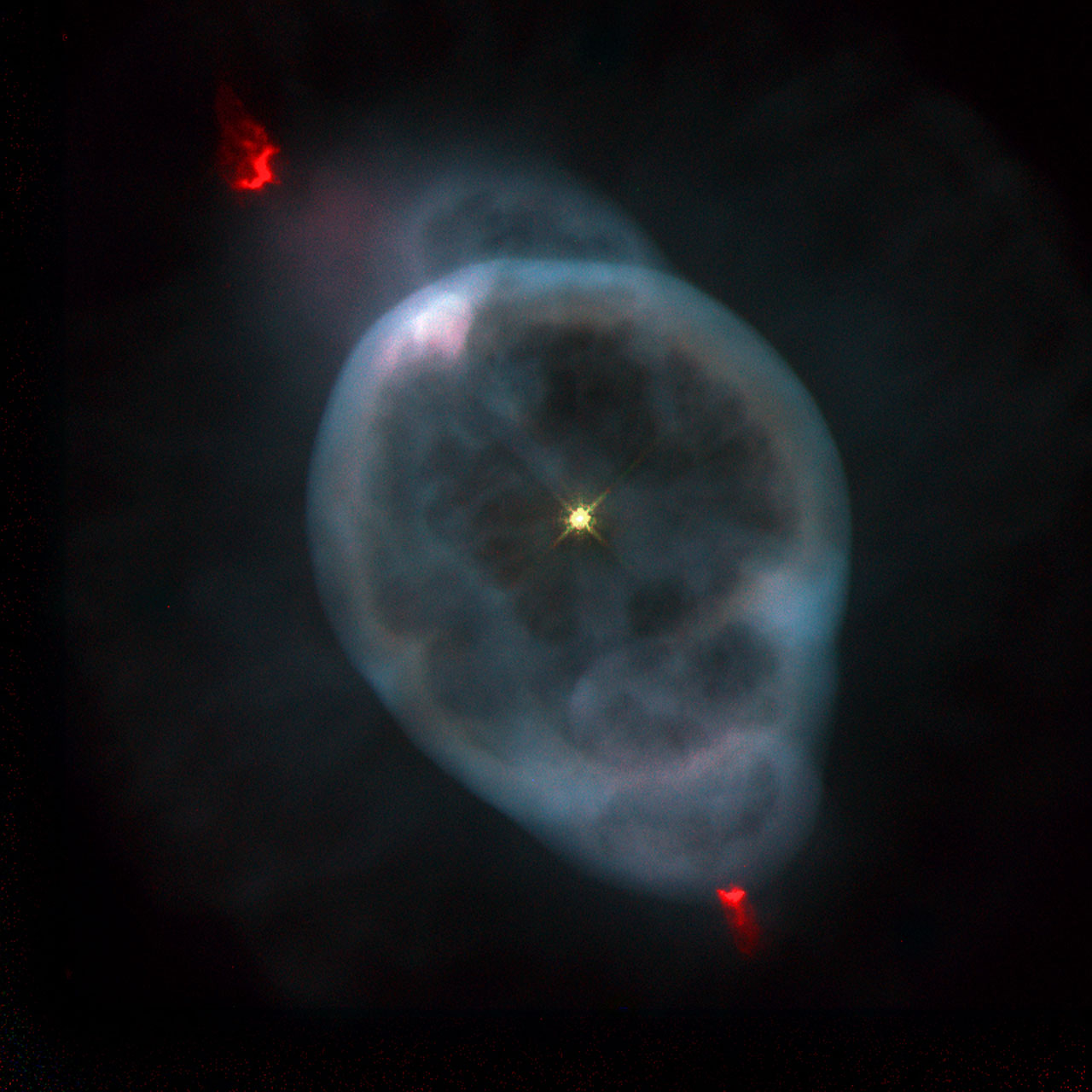
NGC3242
Credit:Danny LaCrue & the ESA/ESO/NASA Photoshop FITS Liberator
https://www.spacetelescope.org/projects/fits_liberator/fitsimages/danny_lacrue_1/
I did not encountered any gcomet like objecth but was impressed by beauty
of tau 1 Hydrae, a double star. The primary looked golden and the
secondary did light blue. At 4:50a.m., 24 minutes after the beginning of
twilight, I identified NGC3242, gGhost of Jupiterh, a planetary nebula.
Though the dark period was five minutes, I was satisfied with the session.
Sunday, September 25
It has been nasty weather for three weeks, and I had no comet
hunting session.
Yesterday, I had an interesting news on 332P Ikeya-Murakami via mailing
list, comet-ml. The
Hubble Space Telescope observed this comet in January 2016, and
scores of fragments were observed.

Fragment A, C (major fragment) and smaller ones of 332P captured by the
Hubble Space Telescope.
Photo is copied from Sky
& Telescope magazine.
Credit: NASA / ESA / D. Jewitt

Hubble Space Telescope made a three-days observation of 332P
Ikeya-Murakami. The square part of the photo above is enlarged. Left is
Fragment C.
http://hubblesite.org/newscenter/archive/releases/2016/35/video/a/
Credit: NASA / ESA / D. Jewitt
The study on the fragmentation of 332P is published in Astrophysical
Journal Letters.
Full text is here.
The first author is D. Jewitt, UCLA, whom I do not know. However, I know
two of the authors. One is Man-To Hui (Wentao Xu, Mandarin Chinese),
Graduate, Planetary Sciences in EPSS, UCLA, and another is Masateru
Ishiguro, Soul National University. I have exchanged email with Hui
for about 10 years and I met him in Cairns,
Australia in 2012 at the time of total solar eclipse.
Ishiguro was an invited speaker of the Annual Comet Conference 2016 in
Fukui, Japan.
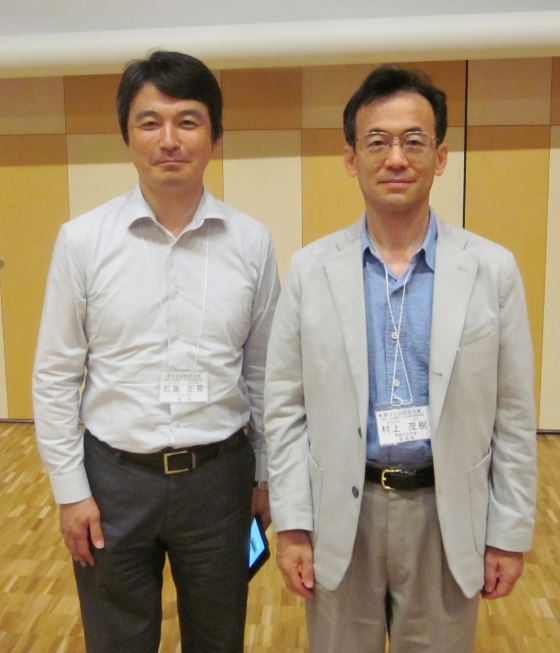
Masateru Ishiguro (left) and me at the Annual Comet Conference in Fukui,
2016.
As described in the article of S&T, it would be difficult to detect
this comet at the next return. Anyway, it was exciting the comet I
discovered exhibited such an interesting phenomenon, and it was observed
by HST.
Wednesday, August 31 to Sunday, September 4
It has been clear sky Wednesday to Sunday except for Friday.
Wednesday, August 31
After passing through a typhoon, the sky has become crystal clear! At
predawn I drove to the usual observing site where I visited last on August
6. However, as I imagined, seeing was poor and star image in the FOV got
swelled. I swept from M1 to Pollux, beta Geminorum. The zodiacal light was
very bright and I could not notice 12th magnitude comet, 43P
Wolf-Harrington.
Thursday, September 1
Contrary to yesterdayfs sky, both transparency and seeing were excellent!
I began with Regel, beta Orionis. I identified no comet like object, but I
enjoyed observing many reflection nebula.
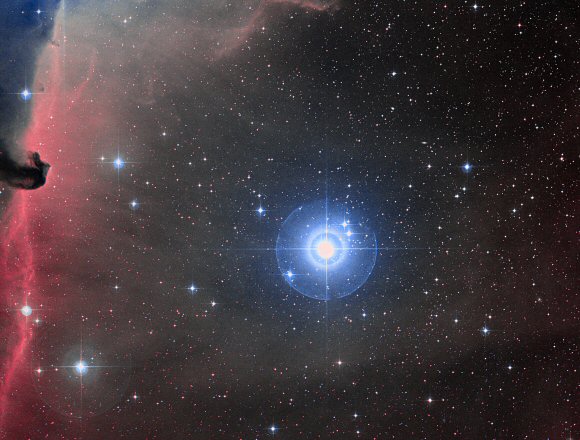
Sigma Orionis and the Horsehead nebula.
http://www.cosmovisions.com/ori.htm
Imago Mundi, © 2011.
The most impressive one was sigma Orionis near the Horsehead nebula. It
looked golden, in actuality, it must look pale blue as it has a spectral
type of B0, and surrounded by a reflection nebula in cobalt blue. I will
never forget this striking image and I believe no photo can reproduce the
beauty of real image. The Horsehead nebula was seen without a filter in
the same FOV, though it was faint.
Saturday, September 3
I started with M78. Transparency was poor and the session was
unsatisfactory. I noticed many reflection nebulae in Orion and Monoceros
like sigma Orionis, but SkiSafari 5 Pro did not show any nebulae.
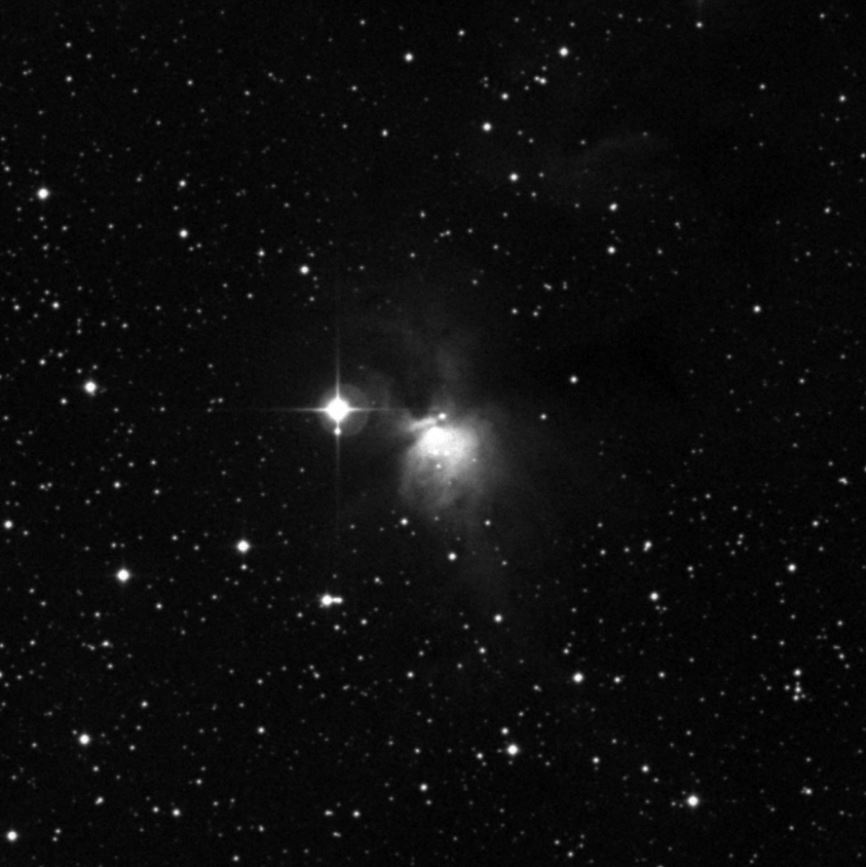
Reflection nebula around V699 Mon. The image is 15f wide.
The Digitized Sky Survey copyright © 1994
Sunday, September 4
Clear sky again! I wanted to sweep the constellation of Eridanus where
there are so many galaxies. I searched this area on August 6, but I
identified no galaxy due to poor transparency. I aimed my comet-seeker at
gamma Eridani and began to search the southern sky. In one minute vary
faint image came into the FOV. The galaxy was identified as PGC13600, a
galaxy with the magnitude of 15.1. It was the darkest DSO I have ever
identified. The distance is 241 M light years. The next one was a galaxy,
PGC13443, the magnitude was 14.7. I observed some 12th and 13th galaxies,
but seeing was bad in altitude of less than 20 degrees.
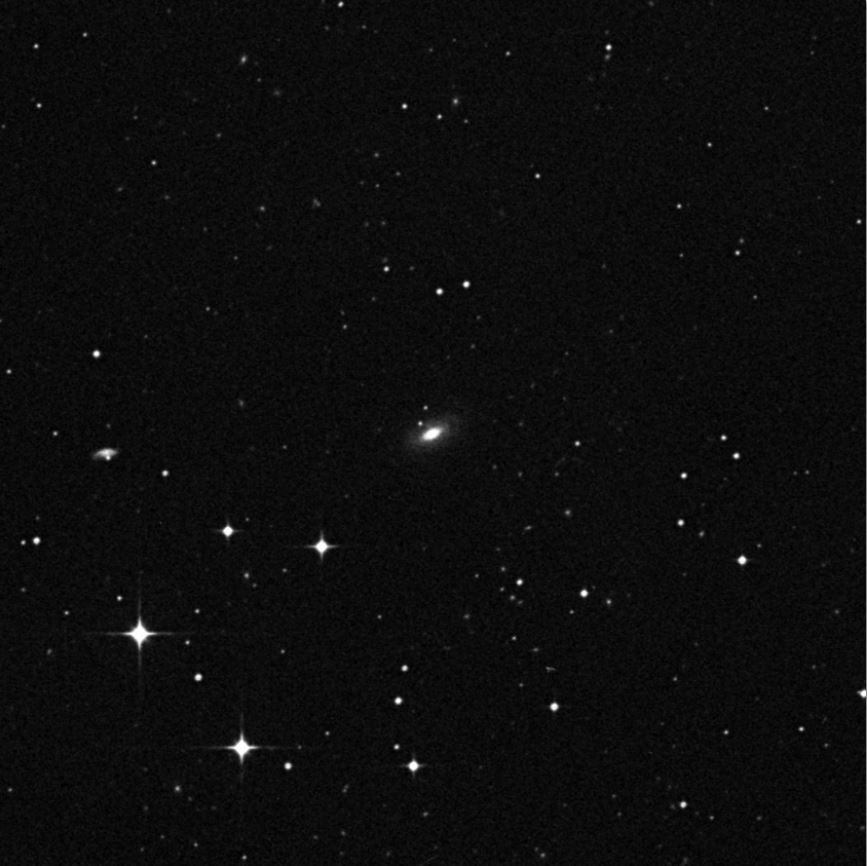
PGC13600, the darkest object I have ever identified. The image is 15f
wide.
The Digitized Sky Survey copyright © 1994
After 40 minutes of search in Eridanus, I wanted to search Sungrazer. I
spent half an hour to sweep the potential area of the comet group, i.e.
along the declination of -5 degree.
In terms of ski condition, only Thursday was satisfactory.
Tuesday, August 16
It has been cloudy and rainy at night and I could hardly comet hunt. The
forecast for this predawn announced last dusk was pessimistic. However,
when I suddenly woke up at 3:20a.m. local time, i.e. 7 minutes before the
beginning of the twilight, the sky was very clear.
If I changed my clothes and went out as soon as possible, I had little
time to comet search. I gave up to go outside, instead I swept the sky
using 17x71 mm telescope from my room. It is Canon EF 200 mm F2.8 camera
lens with Nagler Type 4 12 mm eyepiece. The FOV is 4.8˚ with pinpoint star
image even near the edge of the field.
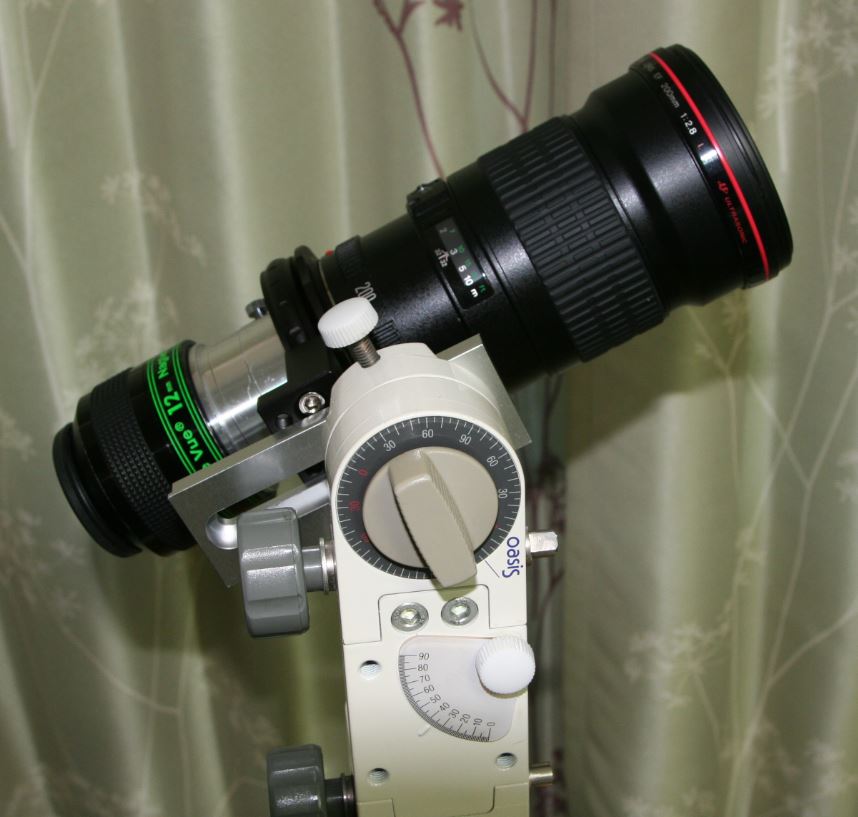
17x71 mm telescope.
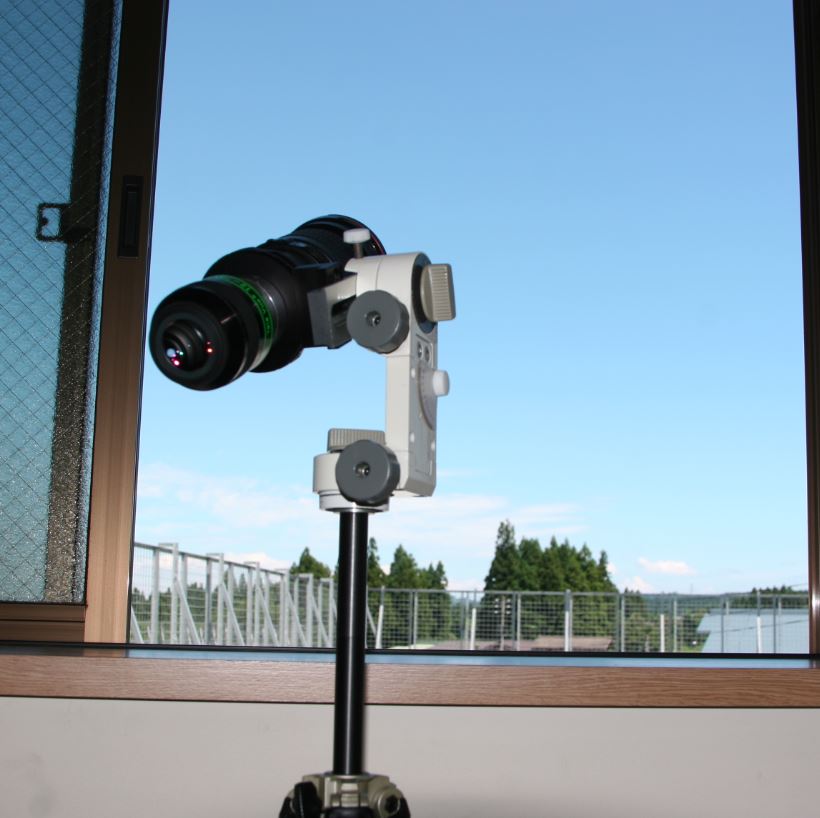
Searching with 17x71 mm from the window. The mounting is BORG 3101
single-arm compact fork mount.
One may think that it is impossible to discover a new comet using such a
small aperture, but the chances are that we can. During todayfs session I
noticed NGC2158, an open cluster in Gemini in the vicinity of M35, when
the altitude of the object was some 30˚ above the horizon. This cluster is
a magnitude of 8.4 with an apparent diameter of 5. The magnitude and the
diameter are similar to those of 332P Iketya-Murakami when this comet was
discovered, though the altitude of the comet at the beginning of twilight
was 12˚ upon discovery.
Genichi Araki, the discoverer of C/1983 H1 Comet IRAS-Araki-Alcock, used
Pentax 300 mm F4 camera lens with Er32 mm eyepiece (9.4x75 mm) and he
discovered the comet from his room. As we have less chance of clear sky in
Niigata area, I longed for such small and easy instrument that enable me
to comet hunt from my room upon sudden clear sky. I own 200 mm F2.8 lens
but I rarely use it recently. I purchased TS
Optics Adapter for Canon EOS Lenses to T2 for CCD cameras - with 1/4"
photo thread and combined it with a threaded ring that I have, I
could build small telescope similar to Arakifs.
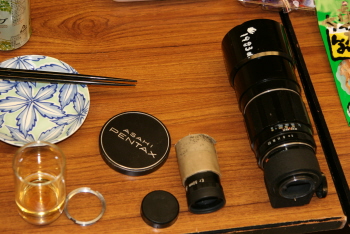
Genichi Arakifs telescope. Photo by author.
See the diary on December 1, 2007. http://comet.la.coocan.jp/diary/2007_diary.html
During the session today, I identified M36, 37 and 38 other than M35 and
NGC2158. I swept 30˚x50˚ during 25 minutes and was content with clear
image.
Tuesday, July 12
I attended Annual Comet Conference in Fukui, Saturday, June 18 to
Sunday, 19 and I met Toru Kobayashi, the discoverer of C/1975 N1
Kobayashi-Berger-Milon. I was attracted to comets as I spotted that comet
by chance after one moth of his discovery at age 13. It was very
impressive to talk with him at the conference.
http://comet.la.coocan.jp/discovery/first/first-disc.html
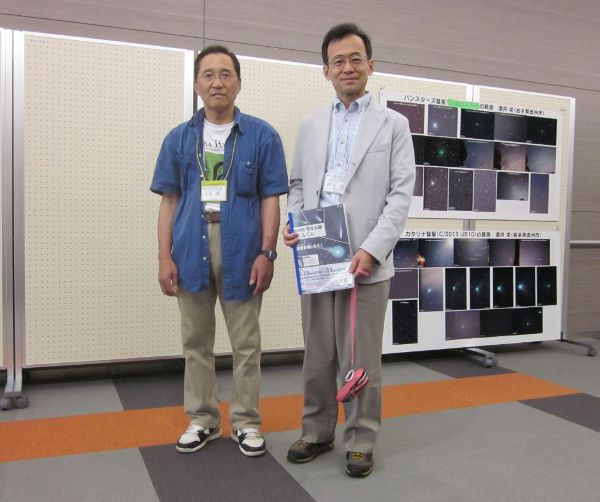
Toru Kobayashi (left) and me.
One month has passed since last comet hunting session. Today the sky
looked clear at a glance, but there was very thin cloud and transparency
was not so good. Air temperature was 16˚C and I wore thin down jacket with
pants.
I began with Hamal, alpha Arietis. The first galaxy I encountered was
NGC672 that has a companion IC1727. Their magnitudes are 10.7 and 11.4,
respectively, but IC1727 looked faint because of low surface brightness.
After I identified NGC890, I stopped the session for a while and trained
my comet-seeker at NGC891, M33 and M31 for 10 minutes. The dark lane in
NGC891 was obvious, and M33 looked like a pinwheel. The spiral structure
of M31 was wonderful though I have observed it many times.

NGC974 galaxy group. The image is 40f wide.
The Digitized Sky Survey copyright © 1994
I resumed the session and bluish-white stars in M45 came into the FOV. I
noticed some of them had reflection nebula. After that I identified
NGC925, a galaxy group of NGC974 (NGC974, 978, 969, 973 and IC1815),
NGC1060 and 1066. There are much more galaxies with magnitude of 13th or
brighter in the area I searched, but I overlooked them due to zodiacal
light and thin cloud.
The sky condition was not satisfactorily, but I enjoyed rare starry sky
during rainy season.
Saturday, June 11
Air temperature was 10˚C higher than that on Monday, i.e., 15˚C.
The sky was almost cloudless except for a rag of cloud in the south. It
was comfortable weather and an arch of the Milky Way over the dark sky was
impressive. M15 was high in the east, 50˚ above the horizon. I aimed my
comet-seeker at this gracious globular cluster and moved it soen 10˚
downword. I began with the altitude of 40˚ at 1:35a.m. local time. The
cloud in the south grew rapidly, and it covered the area I was searching.
At 1:45a.m. I trained my telescope in the northeast, M31, to avoid cloud.
The spiral structure of M31 was clear because the spiral arms were clearly
divided by dark lanes. The faint outer arms extended far from the center
of the galaxy. However, in 13 minutes cloud again hid this area. The only
cloudless area was low in the south and I began to sweep
Aquila-Sagittarius area at 1:58a.m.
A galaxy in Aquila, NGC6814 (mag. 11.4), was the first DSO I identified in
the south. The second was M55, which looked brighter and more beautiful
than ever thanks to the dark sky of the site with the altitude of 950 m
above sea level. The number density of stars in most globular clusters
declines with the distance from the center, i.e., stars are dense at the
center and sparse near the edge. In M55 stars distributes more uniform.
This flat distribution of stars features M55 contrary to M15, in which
stars are densely packed at the center.
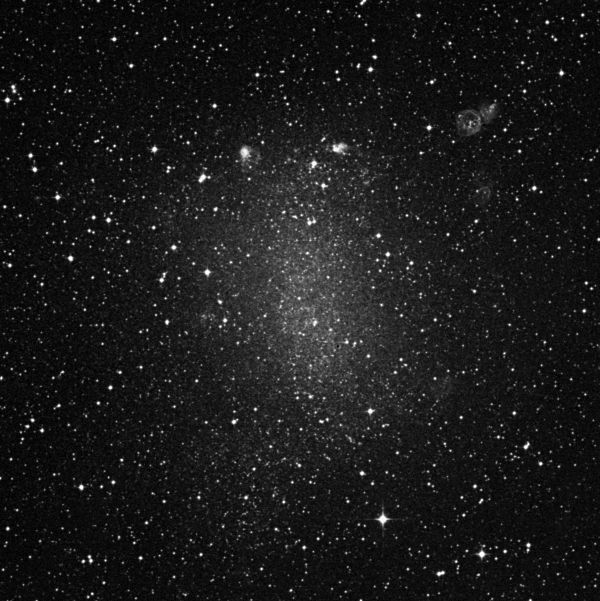
NGC6822, Barnards Galaxy. The image is 20 wide.
The Digitized Sky Survey copyright © 1994
The third DSO was NGC6822, Barnards Galaxy. I observed this irregular
galaxy in Hawaii in 2005 and it was the only observation. The Night Sky
Observers Guide reads under good conditions it can be glimpsed even mere
10x50 binoculars as a N|S smug because of magnitude of 8.7. Nonetheless,
one cannot observe this galaxy if the condition is not good, because the
apparent size of 15x14 and diffused. Again, thanks to the high altitude
of the site I could spot this vague object for the first time during the
searching session.

NGC6835 and 6836. The image is 15 wide.
The Digitized Sky Survey copyright © 1994
Other dark objects I noticed were a pair of galaxies in Sagittarius,
NGC6835 (mag. 12.5) and 6836 (12.9). I spotted NGC6835 in the FOV and then
I noticed NGC6836 when I confirmed the former using SkiSafari 5 Pro on my
iPad mini2 display. I could spot NGC6836 on the FOV of my comet-seeker as
a result. I think I have never identified those galaxies. M75 was the last
DSO I encountered today. At the end of the session, under the twilight,
brilliance of alpha and beta Capricorni was noble and serene.
Friday, June 3
It was a chilly predawn with air temperature of 5˚C at the
observing site. I began to search from alpha Pegasi. I started sweeping
the sky from that star on May 18, but the eastern sky was covered with
cloud, and I wanted to try again. Although there was thin cloud on the
eastern sky, I swept through the cloud and identified NGC7448, a 11th
magnitude galaxy and a pair of 12th magnitude ones, NGC7463 and 7465.
Incredibly, the cloud grew thicker rapidly and hid all constellation on
the east in 3 minutes!
I took a 10-minute rest, and resumed from the south, the only cloudless
direction, specifically, from Saturn. I identified 2 bright globular
clusters, NGC6366 and 6235. However, the southern sky was also covered
with cloud in 10 min.
In turn, the eastern sky was clear, and I resumed with NGC7448. That
galaxy is out of the Great Square of Pegasus, but I identified 10 galaxies
in that square through this session. Among them, a galaxy group of NGC7550
was the most impressive. I could recognize three of them at a glance:
NGC7550 (mag. 12.2), 7549 (13.2) and 7547 (13.6). NGC7553 (14.4) and 7558
(14.9) were too dark to notice.
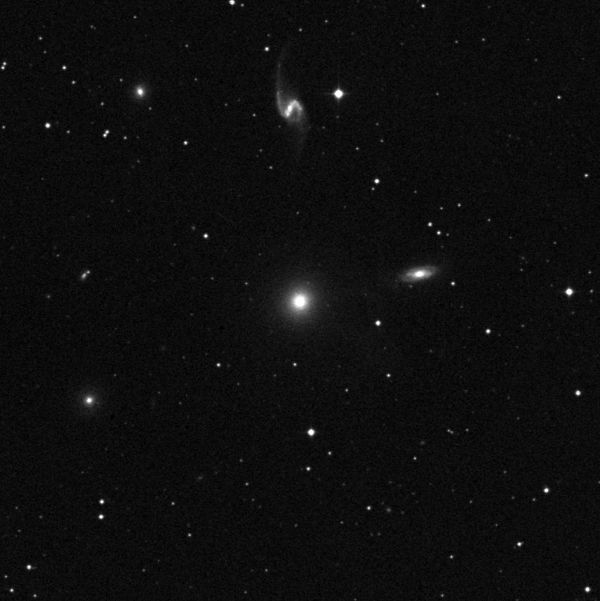
NGC7550 (center), 7549 (upper center), 7547 (right),
7558
(lower left) and 7553(uper
left). The image is 15 wide.
The Digitized Sky Survey copyright © 1994

NGC7578A and B. The other galaxies have no NGC number. The image is 15
wide.
The Digitized Sky Survey copyright © 1994

NGC7769 and 7771. The other galaxies have no NGC number. The image is 15
wide.
The Digitized Sky Survey copyright © 1994
NGC7578 also was an interesting object. Revised NGC catalog divides it
into two galaxies, NGC7578A and B. Both of them are magnitude of 13.9.
NGC7769 (12.0) and 7771 (12.1) also constitute a galaxy group. I did not
notice a darker member, NGC7770 (13.6).
Ten minutes after the beginning of twilight, I observed C/2013 X1
PanSTARRS and 252P LENAER with 46 cm, 97x. C/2013 X1 was very bright some
7th magnitude by intuition, but I did not see the tail probably because of
low altitude. 252P was not detected at a glance, however, peering into the
FOV closely, I detected very faint and defused
diffused image at 2.740 June UT (2:45, 3 June local time). I did not
measure the apparent diameter and brightness, but it had a several arc
minutes in diameter with 14th magnitude by intuition. Some comet observers
reported rapid fading of the comet and visual observers said they could
not see it, but I was lucky to observe it thanks to good sky condition.
It was satisfactorily session, though I was annoyed by cloud. When I took
down my comet-seeker, beautiful crescent moon decorated by earthlight rose
on the eastern horizon.
Wednesday, May 18
Air temperature was 5˚C at the observing site where the altitude is
950 m above sea level. It was very cold and I used disposable heating
pads. Prior to todayfs hunting session, I observed Saturn but I could not
see Cassinifs divide due to poor seeing. I aimed my comet-seeker at Mars
and I noticed some dark areas, but could not recognize the details.
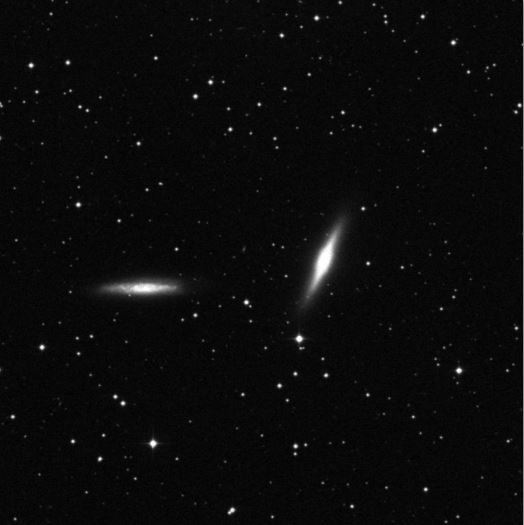
NGC7332 (right) and NGC7339 (left) in Pegasus. The image is 15f wide.
The Digitized Sky Survey copyright © 1994
I began to search at 2:10a.m. with alpha Pegasi under the moonlight. At
2:29a.m. I identified the first DSOs, NGC7332 (11th mag.) and 7339 (12th
mag.), galaxies in Pegasus. They were in the same FOV. The background in
the FOV was getting darker and darker with time, because the moonset was
at 2:41a.m. However, before the moonset, thin cloud spread the eastern
sky. I turned to the north and identified NGC2146, a 10th magnitude galaxy
in Camelopardalis. In five minutes the northern sky also covered with
cloud.
The only clear part of the sky was the south. I
trained my comet-seeker at M22 and resumed from the globular cluster. Many
DSOs passed through the FOV. When NGC6712, a globular cluster in Scutum,
came into the FOV, I noticed a comet like object was in the same FOV! I
though it must be a comet but I did not know if it was a known one or not.

IC1295 (left) and NGC6712 (right). The image is 40f wide.
The Digitized Sky Survey copyright © 1994
I checked the display on my iPad mini2 and the SkySafari 5 Pro indicated
IC1295, a planetary nebula, with NGC6712. This was the first time for me
to identify the planetary nebula. The reason was obvious. I searched the
area for the first time at the site with the altitude of 950 m and thanks
to high transparency of the site I could notice the faint planetary
nebula. It was exciting while I identified the unknown object. I forgot
when I felt a thrill of joy last.
Friday May 13 and Sunday May 15
Finally, I could comet hunt for the first time in May. I did last
on Saturday April 16 but since then it had been cloudy or very hazy except
for the full moon period.
For example, I got up at 0:40a.m. local time on Thursday May 5 (the
twilight begins at 3a.m.) and headed for the observing site but I noticed
the sky got cloudy on the way to the site. I got back my home as I had no
other choice. The next predawn, Friday May 6, the sky was clear and I
drove to the site but when I arrived there at 1a.m. the sky was completely
covered with the cloud. Again, I was forced to return home. On Sunday May
8 and Monday May 9, the forecast predicted clear sky on both days, it was
out of mark: at 0:30a.m. it was cloudy. I was dispirited those days at
predawn. This is the fate of the area where I live that makes me to make
much more effort than in the region where the chance of clear sky is high.
In addition to that there were some days when it was too hazy to comet
hunt though it was cloudless at predawn in April.
Friday May 13
There existed a thin cloud on the eastern sky where I wanted to sweep. I
made an alignment the digital setting circles using Polaris and Enif,
epsilon Pegasi, and started comet hunting from the latter. M15 that was
the same azimuth with Enif came into the FOV pretty soon after the
beginning of the session. The cloud got thicker and thicker with time, and
I could not last the reaching in the east. In 30 minutes I trained my
comet-seeker at M7, the south, where there was no cloud and swept from
there.
I identified over 20 deep sky objects; most of them were globular
clusters. Among those the reflection nebulae, NGC6726 and 6727 in the
constellation of Corona Austrina, with the globular cluster, NGC6723 in
Sagittarius, were the most impressive. Those were in the same FOV.

Center: reflection nebulae NGC6726 and 6727, Upper right: globular cluster
NGC6723
Original image: http://astro.i-net.hu/node/124
Photo by Gábor Tóth
I could not recognize the color of those objects as shown above photo, but
rich star field with dark nebulae around the objects made them more
wonderful. As far as I can remember I have never identified NGC6726 and
6727 during the searching session, probably because they are low in the
south. Today, I noticed the objects as I swept the area when these objects
were nearly in the culmination. I enjoyed gorgeous southern sky view
thanks to the cloud in the east.
Sunday May 15
I started with M15 as I could not search enough the east yesterday. I
expected C/2013 X1 Pan STRRES might come into the FOV, however, the comet
was too low to be observable: it was above the horizon but wad hidden by
trees.
Contrary to Fridayfs session the only DSO I encountered other than M15 was
NGC7448, a galaxy in Pegasus (11th mag.). I knew there are many 11th and
12th magnitude galaxies in the area but I could not observe them due to
poor transparency.
I swept 30˚ horizontally ~ 40˚ vertically in one hour and half. I enjoyed
observing M13 and Saturn with a magnification of 339 after the session.
They were splendid under a good seeing!
Saturday, April 9
Upon arrival of the site, I observed 252P LINEAE using my some
35-years-old 7x50 binocular. The comet was easy to see. Then I could see
the comet with naked eyes. It looked brighter than M13. With my 46 cm
comet-seeker 97x, the apparent diameter was about 15f, smaller than on
Wednesday, because of deteriorated air condition.
I began with around 5˚ north of the gamma Cygni. The first DSO I observed
was NGC6846, a 14th magnitude open cluster in Cygnus. It looked like a
galaxy at the edge of the FOV. As time went by, the eastern sky got
cloudy. A layer of thin cloud began to covet the east. I identified
brighter part of the vail nebula, NGC6992-5, but could not darker one,
NGC6960. The filament structure of the nebula was wonderful even without a
filter. After 40 minutes sweeping of the eastern sky, I changed the search
area to the north.
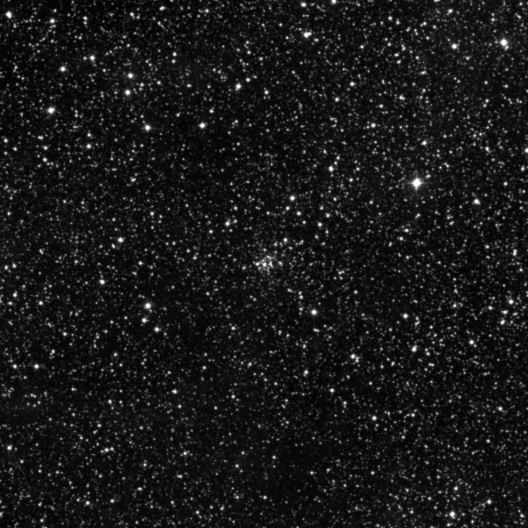
NGC6846. Fourteenth magnitude open cluster in Cygnus. The image is 20f
wide.
The Digitized Sky Survey copyright © 1994
I trained my comet-seeker at the beta Ursa Minoris where I continued the
session. I came across 12 galaxies in the north. The faintest one was
NGC5832 located at 2.5˚SSW of the
Beta Ursa Minoris. The brightness of the galaxy is described as12th in NGC
catalog, but 13.6 in SkiSafari 5 Pro.
The highlight of todayfs DSO was a galaxy group. NGC4386, 4291 and 4589 in
Draco. NGC4219 is a 12th magnitude and the others are 11th.
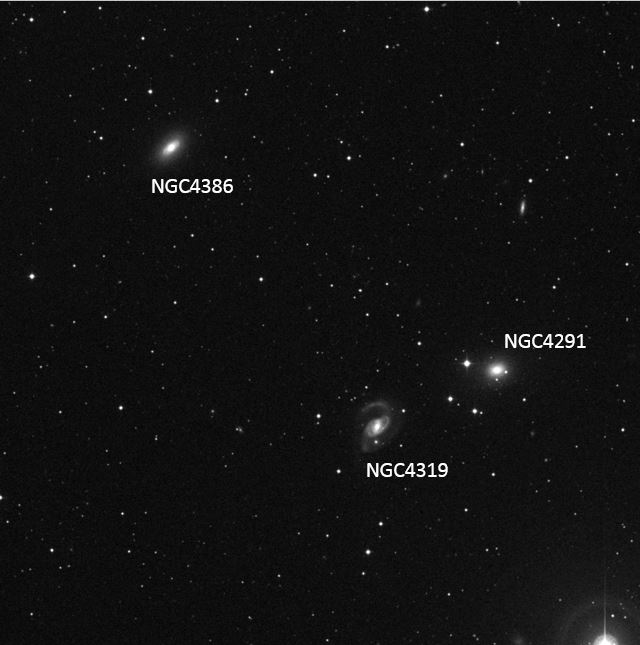
Galaxy group. NGC4386, 4291 and 4589. The image is 30f wide.
The Digitized Sky Survey copyright © 1994
M82 with M81 that I observed in the twilight left a vivid impression, as
they looked like expanded version of the galaxies I met today.
Wednesday, April 6
The first comet hunting session this month. There were some
cloudless days but as is usual with the spring in Japan, the air was too
hazy to conduct a comet hunting in some days.
I tried observing 252P LINEAR at the end of March, but I could not due to
moonlight with light pollution. This predawn I observed the comet with
ease. It had a large apparent diameter of some 20f with a short broad tail
extending on the west. The comet approached M14 and the both object were
in the same FOV, though parts of them protruded out of the FOV. Anyway, it
was a great view.
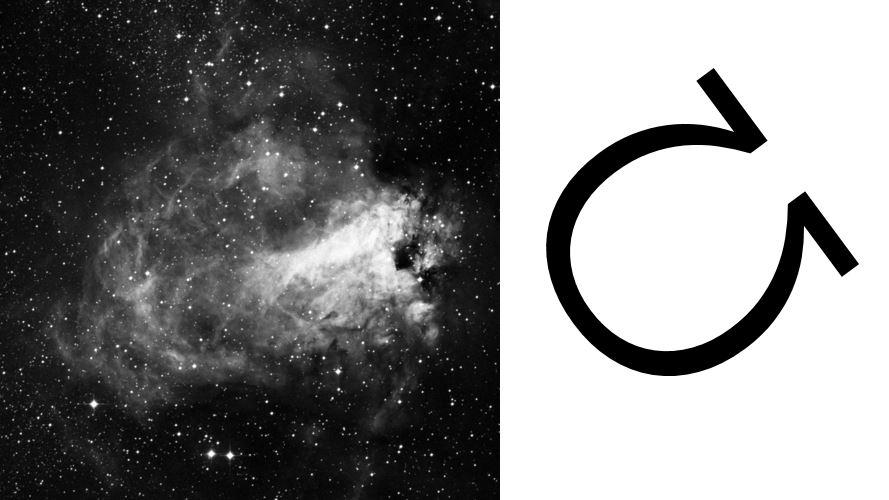
M17 looked ¶ shaped. The image is 30f wide.
The Digitized Sky Survey copyright © 1994
The origin of todayfs session was 252P. I moved my comet-seeker downward
from the comet. In a minute I encountered NGC6583, an open cluster in
Sagittarius. There were many globular clusters in the area I swept like
M28, M70, NGC6642, M22, M54 and Palomar 8. Each cluster has its feature.
NGC6723, a 6th magnitude large globular cluster in Sagittarius came into
the FOV when whose altitude was 8 ˚ above the horizon. The image was very
faint. M17 looked like a Greek alphabet, ¶, at a glance thanks to the good
transparency.
In the Milky Way in Scutum starry fields and starless areas mixed together
that was the most impressive view in the session. M11, a brilliant star
cluster, was the last DSO I identified.
Thursday, March 17
Luckily, I comet hunted two consecutive predawn, yesterday and
today. Masamitsu Nakamura, a Japanese comet discoverer, who lives in
Shizuoka, the same Prefecture with Kaoru Ikeya, emailed me and said it has
been clear sky for a week. Here in Tohkamachi the chance of clear sky is
one third or less of Shizuoka. This predawn air temperature was +2˚C with
weak wind and the transparency was excellent. The weather and the sky
condition were superb like yesterday.
I started the session with Altair, alpha Aquilae. It was a great joy to
sweep the Milky Way under the dark sky condition; faint star field made
the sound of a cembalo and a group of bright stars that suddenly came into
the FOV played a musical percussion that was strongly beaten in my mind.
Abruptly, the orchestra reduced the sound they were playing when dark
nebulae appeared in the concert hall named the Milky Way. Each individual
stars has its beauty. They looked like gold powder or gems spread on the
absolutely black sky.
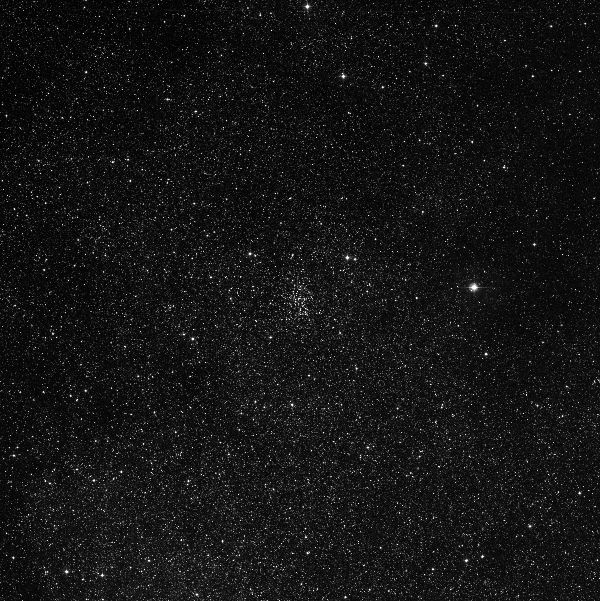
NGC6802. An open cluster in the constellation of Vulpecula. The image is
1˚ wide. Note that the number of stars in the upper right and the upper
left is less than the lower part of the image due to the presence of dark
nebulae.
The Digitized Sky Survey copyright © 1994
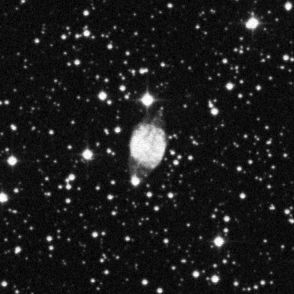
NGC6905. An 11th magnitude planetary nebula in Delphinus. The image is 5f
wide.
The Digitized Sky Survey copyright © 1994
NGC6802 is elongated open cluster in the constellation of Vulpecula. Even
such a minor cluster presents an impressive view with my 46 cm
comet-seeker and good sky condition. NGC6905 is a planetary nebula in
Delphinus with an interesting appearance. I wanted to observe with higher
magnification but I did not to save time. There are some planetary nebula
around the NGC6905 with 11th magnitude like NGC6886 but their apparent
diameters are too small to notice.
At 4:01a.m. local time, M2, a globular cluster, with an altitude of only
4˚ came into the FOV. The globular cluster is 6.6 magnitude, but looked
like a 10th magnitude due to the low altitude. I felt I could notice the
image if it was 9th magnitude, but it was difficult if it was 10th. M27, a
planetary nebula looked rugby-ball shaped as fainter part of the nebula
was easily noticed.
I can keep the hunting session because the stars are beautiful.
Sunday, March 6, 2016
I finished setting up my comet-seeker at 3:10a.m. local time. It
was very warm with air temperature of 6˚C that was caused by a foehn
phenomenon. At the time of arrival on the site I wanted to sweep the
eastern sky, but cloud covered the direction when I was ready. I tried to
train my telescope at the southeast where the sky was clear, however, I
needed to move my car as I parked it on the southern side of my
comet-seeker. The wind was strong and I thought I used my car as a wind
screen. I could manage to avoid the strong wind as the building nearby
also worked as the wind screen. It took over 10 minutes to move my car and
to make some rearrangement.
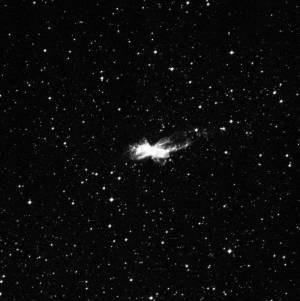
NGC6302. The image is 15f wide.
The Digitized Sky Survey copyright © 1994
At 3:25 I started todayfs session from M4, a globular cluster in Scorpion.
In one minute, I was forced to change the eyepiece from Ethos 21 mm 97x to
Paracorr + Planocular 30 m 78x to reduce the magnification. Seeing was too
poor to peer into the FOV with attention. Even the magnification of 78x
the star image was somewhat swelled at the altitude of 40˚. Actually,
transparency also was not very good. After identifying M80, an interesting
planetary nebula, NGC6302, came into the FOV. The apparent diameter of the
nebula is small, 72hx30h, in addition to low altitude of only 10˚ above
the horizon when I observed it at 3:52a.m., it was challenging to
distinguish the object from stars. The nebula looked an asterism at a
glance. I identified the nebula several times in the past, but today, the
condition was severe to notice it but I could manage to see.
At 4:00a.m. the southeastern sky was covered with cloud. I took a break
and resumed the session from M56 in 10 minutes. I put off my wool cap as
wind stopped and I felt too warm. In several minutes, wind began to blow
again and I put on my wool cap again. I did the same thing for my down
jacket earlier today too. I could not concentrate on the session due to
rapid changes in the weather condition. Even so, the session gave me
mental and physical vitality.
Friday, February 12
I got up at 2:30a.m. local time. It must be clear sky. I could not
open the window in my bed room as it froze and I could not see the sky
from the room. I checked air temperature and wind seed at the
meteorological station nearest of my house gTohkamachih and that of the
observing site gTsunanh using Internet prior to heading to the site. At
2a.m. at Tohkamachi with an altitude of 170 m a.s.l. it was -4.7˚C with
gentle wind but at Tsunan 452 m a.s.l. air temperature was much higher,
+1.6˚C with strong wind, 5.1 m/s. This kind of temperature inverse in
terms of the altitude can happen known as inversion. On my way to the site
thermometer installed in my car indicated actually -4˚C and at the site it
did +1˚C, both were the same as the meteorological stations.
It was warm but the wind was strong as I knew earlier. Without hesitation,
I set up my comet-seeker under the lee of a building. However, this was
the wrong choice that I noticed later.
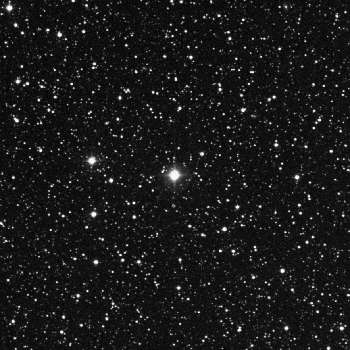
Planetary nebula, NGC6572 (center). Looks like a star. The image is 15f
wide.
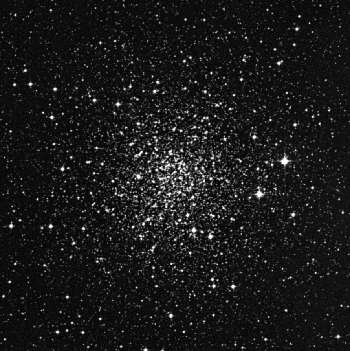
Globular cluster, NGC6366. The image is 15f wide.
Before the start of the session, I aimed my telescope at the two bright
DSOs in Ophiuchus that I wondered why I have never noticed. As I mentioned
on the diary on February 8, one was a planetary nebula, NGC6572 with the
magnitude of 8.1, and another was globular cluster, NGC6366 with the
magnitude of 9.5 or 10.0 depending on the catalog. I noticed NGC6572 with
97x since I confirmed the position of the object on the map just before
the observation and peered into the FOV consciously. Nevertheless, it
looked like a star and I felt I overlook the object if I sweep the sky as
usual. The apparent diameter (only 0.13f) is too small to notice. At
4:00a.m. I could not detect NGC6366 probably because the altitude was only
22 degrees. At 5:00a.m. I tried it again and I saw NGC6366. Based on NGC
(revised NGC) catalog the apparent diameter is 8f (13f) that is very large
for the total brightness, which makes it challenging to identify this
object during a comet hunting session.
I began the session with M11 at 4:05a.m. with a magnification of 97, but I
changed the eyepiece and reduced it to 78x soon after the start of the
session as seeing was poor. Stars in the FOV were swelled in particular at
low altitude due to bad seeing caused by strong wind. With 78x star image
was improved drastically, and I swept the sky comfortably. In the northern
area of M11 (I usually sweep toward the north in the eastern sky) there
are no comet like objects that can be seen with my comet-seeker; I
identified no DSOs except for many open clusters.
About a quarter before 5a.m. suddenly, a gust of wind rotated my telescope
a few degrees and at the same time drifting snow fell on me and the
comet-seeker. I noticed snow was originated from the roof of the building!
Until last year I avoided to set my comet-seeker up at the lee of the
building even if the wind was strong to avoid drifting snow from the roof.
I completely forgot about it this time. Drifting snow happened several
times since then. I looked into the primary mirror and there were a dozen
of snow particles on the mirror. I thought they would evaporate soon and
continued hunting. At the end of the session there were only a few snow
particles on the mirror. Snow particles did not stain the mirror surface.
Astronomers must pay attention to weather condition and how to deal with
an accident caused by it.
Monday, February 8
Disintegration of P/2010 V1 Ikeya-Murakami has progressed and there seems
to be 10
fragments in total. The comet is getting brighter dramatically from
a magnitude of 20.8 at the time of recovery (Dec. 31, 2015) to 17th.
Fragment D shown on the photo of the comet by Pieter-Jan Dekelver was
actually, Fragment E. I replaced old photo with the
revised one.
The first hunting session in February. It is rare occasion to comet search
in February as nasty weather continues in usual. I arrived at the site at
3:20a.m. The air temperature that time was -7˚C that was the lowest record
this winter. The nearest meteorological station recorded -10.5˚C and I
guess the lowest temperature at the site was almost the same. I was
thickly dressed and slow in action. I spent a lot of time to set up my
comet-seeker, and I started hunting at 4:05a.m., i.e. taking 45 minutes
for preparation.
During the warm season I placed iPad mini 2 on the stepladder, but this
method is inappropriate in winter; the device gets out of battery in a
short time due to cooling. Instead, I put iPad mini2 in my car and
sandwich it between the two floor cushions to keep it warm.

iPad mini 2 attached the stepladder.
I felt that the transparency was not so good and that the light pollution
was rather strong. I noticed this was not mainly because city light is
reflected by snow, i.e. snow light, but because I was accustomed to dark
sky at the site with an altitude of 950 m above sea level during autumn.
The high altitude site in autumn is snowless, less light polluted and less
dusty.
I began with M12, a globular cluster in Ophiuchus. Soon after, M10, a
globular cluster in the same constellation came into the FOV, which
consists of more star and more impressive. At 4:30a.m. I encountered M17,
Swan nebula. The altitude of M17 was only 8˚. It was floating on the Milky
Way today, but when it rose higher the shape looks like Greek letter
gOmegah, known as another nickname of the object. The next DSO identified
was M14. Stars near the edge of the globular cluster were resolved with
averted vision, but less impressive than M12 and M10 due to low altitude.
As I remember I have never identified NGC6366, 10th magnitude globular
cluster, near M14 probably due to low surface brightness. The fifth DSO
encountered was NGC6384, a galaxy. I think this was the first time that I
identified the galaxy. I suppose this is due to higher magnification I
use, i.e. 97x, since December 2014.
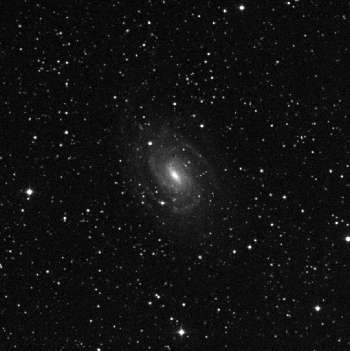
NGC6384, a galaxy in Ophiuchus. The field is 15f wide.
The Digitized Sky Survey copyright © 1994
The next DSO was also a globular cluster, NGC6535, which I will never
forget. Just before I
discovered C/2002 E2 Snyder-Murakami, I encountered this cluster.
Another globular cluster I identified at that time was NGC6426 but could
not notice it today. NGC6426 is a bit darker than NGC6535. The new comet
was darker than NGC6535 (magnitude of 10.6) but brighter than NGC6426
(11.2).
In the constellation of Scutum, NGC6712 came into the FOV. This globular
cluster is also nostalgic object. February 26 in 2004 local time
I spotted a possible comet. It was 7th magnitude but no one
including me could not observe this object the next day. The unconfirmed
comet was shining some 4˚ south of NGC6712. Prof. Junich Watanabe told me
the comet must be a near earth object and it was lost due to high motion.
I was impressed by his penetrating insight.
The last DSO I met was M11, a brilliant open cluster in Scutum.
The weather pattern this year is obviously different from that of usual
and it is expected another clear sky in a week. I will prepare for the
next chance.
Saturday, January 9
Tuesday, January 19
Further disintegration of P/2010 V1 Ikeya-Murakami
Fragment B of P/2010 V1 Ikeya-Murakami disintegrated into fragment
C and D. The fragment B seems to be very fragile and it may yield
additional breakup.

Click
to enlarge
Copyright: Mr. Pieter-Jan Dekelver. Maasmechelen, Belgium
Observatory Gromme
- MPC: D09
On Sunday, regrettably, the sky was clear at predawn but I was unprepared
and did not get up. Today, I comet hunted for the first time this year,
though last night it was raining at 9p.m. local time. At that time the
forecast predicted that the central part of Niigata Prefecture (Chuetsu
area) was snowy at predawn on Tuesday, however, I carefully looked at the
weather chart and the mesh weather forecast and I believed clear sky at
predawn and prepared.
Snow depth near my house and at the site was only some 30 cm and 50 cm,
respectively, contrary to last year, some 2 m and 3 m, respectively. When
I arrived at the site (not the site with an altitude of 950 m where closed
due to snow, but with 425 m) at 3:30a.m. local time air temperature was
1˚C. During the comet hunting session it reduced to -1˚C and no need to
turn on the heater installed vest. So far climate in this winter has been
mild.
I wanted to search the southeastern sky, the direction of Tokyo
metropolitan area where obvious light pollution exists at lower part of
the sky, but the amount of cloud increased up to 80% when I set up my
comet-seeker. I was forced to sweep the northeast where there existed a
gap in the cloud. I identified M92 and M57 but the amount of cloud
decreased as time went. I took a break during the session and observed
C/2013 US10 Catalina. The two tails were obvious, and the structure of the
ion tail was interesting. Half an hour after the beginning of the session,
I trained my telescope at the southeast where I wanted to search as the
sky got cloudless except for low altitude; I started with Zubenelgenubi,
alpha Librae.

NGC5861 (lower left) and 5858 (upper right). The field is 15f in width.
The Digitized Sky Survey copyright © 1994
DSOs that I encountered were NGC5634 (globular cluster), 5791, 5729, 5898,
5903, 5897 (globular cluster), 5861, 5858, and two globular clusters M4
and M80. Though it was a moonless night, the sky was rather bright due to
snow light in addition to light pollution, and I missed many 11th
magnitude galaxies in the area. Having said that, I wondered if there are
so many galaxies in the area. I seldom searched the area in January when
the constellation of Libra rises at predawn because of snowy weather, and
seldom did with 97x as I began to use Ethos 21 mm since December 2014,
i.e. about one year ago. Higher magnification, 97x, enables me to identify
darker galaxies. For those reasons galaxies in Libra were fresh for me.
The faintest one I identified was NGC5858 (magnitude of 12.8), but I
spotted this galaxy when I noticed NGC5861 (magnitude of 11.6) that was in
the same FOV with the former. NGC5634 is the only globular cluster in
Virgo and is bright with a magnitude of 9.5, but I cannot remember if I
have ever encountered this object. Maybe, I have overlooked it as it has
small apparent diameter and I spotted it thanks to 97x. It was
satisfactorily session.
Recovery of 331P (P/2010 V1) Ikeya-Murakami
On Saturday, January 2, Japanese amateur astronomer, Hidetaka Sato,
pointed out that the two objects posted on PCCP that were detected by
Pan-STARR telescope in Hawaii was possibley P/2010 V1 Ikeya-Murakami. He
thought one of them was disintegrated fragment of the comet. On the same
day, the object was confirmed as P/2010 V1 based on the interconnection of
the orbital calculation.
http://www.minorplanetcenter.net/mpec/K16/K16A10.html
On Sunday, January 3, French amateur astronomer, Francois Kugel, observed
the fragment,
http://lesia.obspm.fr/comets/lib/display-obs1.php?Num=14980
and the fragment also confirmed officially.
http://www.minorplanetcenter.net/mpec/K16/K16A36.html
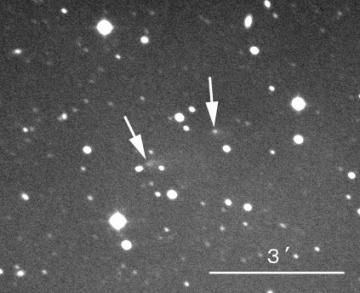
331P Ikeya Murakami. Right: fragment A, Left: Fragment B
Jan. 3.65, 2016 UT. 103 cm reflector. Copyright Takaaki Oribe, Saji
Observatory, Japan.
I was afraid that the comet might not be recovered and became a lost comet
if outburst does not occur. Both fragments were very dark, 19th magnitude,
and surprisingly, disintegrated. Ironically, the recovery was made by the
Pan-STARRS telescope that is enemy for amateur comet hunters. But if it
were not for the Pan-STARRS the comet might be lost.
A chance of visual observation of this comet using my 46 cm comet-seeker
is impossible unless outburst occurs. Anyway, I am glad the comet was
recovered.
Top of this page
























